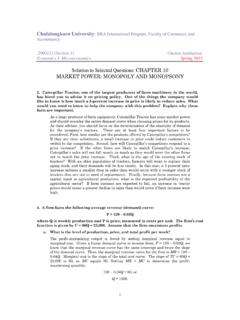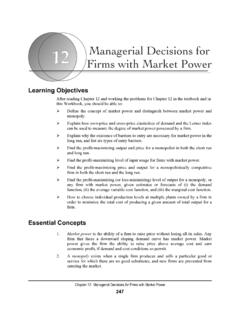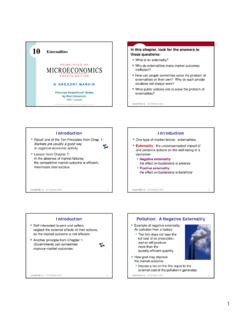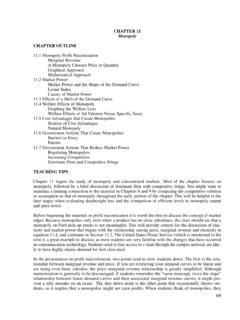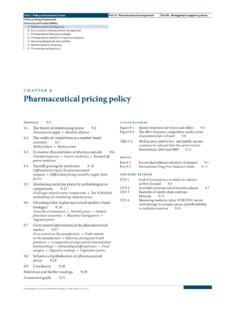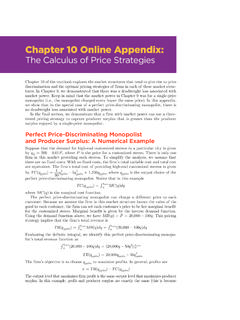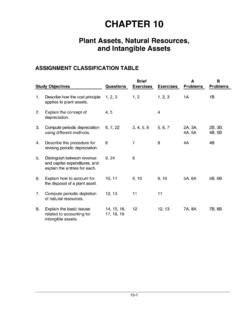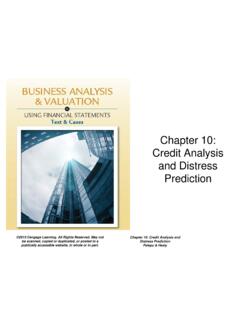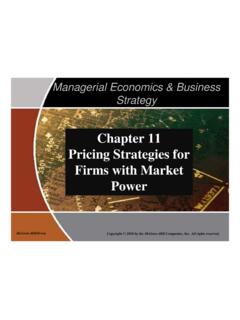Transcription of Market Power: Monopoly and Monopsony - …
1 Copyright 2013 Pearson Education, Inc. Publishing as Prentice Hall. chapter 10 Market power : Monopoly and Monopsony Review Questions 1. A monopolist is producing at a point at which marginal cost exceeds marginal revenue. How should it adjust its output to increase profit? When marginal cost is greater than marginal revenue, the cost of producing the last unit is greater than the additional revenue from the sale of the last unit, so the firm loses money on that unit. The firm would increase profit by not producing as many units. It should reduce production, thereby decreasing marginal cost and increasing marginal revenue, until marginal cost is equal to marginal revenue. The diagram shows this situation. The firm is producing an output like Q , where MC > MR. The firm should decrease output until it reaches the profit-maximizing output Q*. 2. We write the percentage markup of prices over marginal cost as (P MC)/P.
2 For a profit-maximizing monopolist, how does this markup depend on the elasticity of demand? Why can this markup be viewed as a measure of Monopoly power ? Equation on page 363 shows that the markup percentage is equal to the negative inverse of the price elasticity of demand. 1dP MCPE . Therefore, as demand becomes more elastic (Ed becomes more negative), the markup percentage becomes smaller. For example, if Ed changes from 2 to 5, the markup decreases from to This tells us that the firm has less power to mark up its price above marginal cost when it faces a more elastic demand. Therefore, the markup percentage can be viewed as a measure of Monopoly power . 3. Why is there no Market supply curve under conditions of Monopoly ? 164 Pindyck/Rubinfeld, Microeconomics, Eighth Edition Copyright 2013 Pearson Education, Inc. Publishing as Prentice Hall. The monopolist s output decision depends not only on marginal cost, but also on the demand curve.
3 Shifts in demand do not trace out a series of prices and quantities that we can identify as the supply curve for the firm. Instead, shifts in demand lead to changes in price, output, or both. Thus there is no one-to-one correspondence between the price and the seller s quantity; therefore, a monopolized Market lacks a supply curve. 4. Why might a firm have Monopoly power even if it is not the only producer in the Market ? A firm can have some Monopoly power if its product is differentiated from other firms products, and if some consumers prefer its product to other firms products. A firm might also be located more conveniently for some consumers. These differences allow the firm to charge a price above its marginal cost and different from its rivals. 5. What are some of the different types of barriers to entry that give rise to Monopoly power ? Give an example of each.
4 There are several types of barriers to entry, including exclusive rights ( , patents, copyrights, and licenses), control of an essential resource, and economies of scale. Exclusive rights are legally granted property rights to produce or distribute a good or service. Complete control over an essential raw material such as bauxite to produce aluminum or oil to produce gasoline prevents other firms from producing the same product. Large economies of scale lead to natural monopolies because the largest producer can charge a lower price, driving competition from the Market . For example, in the production of aluminum, there is evidence to suggest that there are scale economies in the conversion of bauxite to alumina. (See v. Aluminum Company of America, 148 416 [1945], discussed in Exercise 10, below.) 6. What factors determine the amount of Monopoly power an individual firm is likely to have?
5 Explain each one briefly. Three factors determine the firm s elasticity of demand and hence its Market power : (1) the elasticity of Market demand, (2) the number of firms in the Market , and (3) the interaction among firms in the Market . The elasticity of Market demand depends on the uniqueness of the product, , how easy it is for consumers to substitute for the product. As the number of firms in the Market increases, the demand elasticity facing each firm increases because customers have more choices. The number of firms in the Market is determined by how easy it is to enter the industry (the height of barriers to entry). Finally, the ability to raise price above marginal cost depends on how other firms react to the firm s price changes. If other firms match price changes, customers have little incentive to switch to another supplier, and this increases Market power .
6 7. Why is there a social cost to Monopoly power ? If the gains to producers from Monopoly power could be redistributed to consumers, would the social cost of Monopoly power be eliminated? Explain briefly. When the firm exploits its Monopoly power by charging a price above marginal cost, consumers buy less at the higher price, and consumer surplus decreases. Some of the lost consumer surplus is not captured by the seller, however, because the quantity produced and consumed decreases at the higher price, and this is a deadweight loss to society. Therefore, if the gains to producers were redistributed to consumers, society would still suffer the deadweight loss. Copyright 2013 Pearson Education, Inc. Publishing as Prentice Hall. 8. Why will a monopolist s output increase if the government forces it to lower its price? If the government wants to set a price ceiling that maximizes the monopolist s output, what price should it set?
7 By restricting price to be below the monopolist s profit-maximizing price, the government can change the shape of the firm s marginal revenue curve. When a price ceiling is imposed, MR is equal to the price ceiling for all quantities less than or equal to the quantity demanded at the price ceiling. For example, in the diagram the price ceiling is set at P , which is below the profit-maximizing price P*. The MR curve becomes the line P A and then jumps down to B and follows the original MR curve beyond that point. The optimal output for the monopolist is then Q , which is greater than the profit-maximizing output. If the government wants to maximize output, it should set a price ceiling at the point where the demand curve and the marginal cost curve intersect, point C in the diagram. Then, when the firm produces where MR MC, it will be producing the output level at which P MC, where P is the price ceiling.
8 In this way, the government can induce the monopolist to produce the competitive level of output. If the price ceiling is set below this point, the monopolist will decrease output below the competitive level. 9. How should a monopsonist decide how much of a product to buy? Will it buy more or less than a competitive buyer? Explain briefly. The marginal expenditure is the change in the total expenditure as the purchased quantity changes. For a firm competing with many firms for inputs, the marginal expenditure is equal to the average expenditure (price). For a monopsonist, the marginal expenditure curve lies above the average expenditure curve because the decision to buy an extra unit raises the price that must be paid for all units, including the last unit. All firms should buy inputs so that the marginal value of the last unit is equal to the marginal expenditure on that unit.
9 This is true for both the competitive buyer and the monopsonist. However, because the monopsonist s marginal expenditure curve lies above the average expenditure curve and because the marginal value curve is downward sloping, the monopsonist buys less than a firm would buy in a competitive Market . 10. What is meant by the term Monopsony power ? Why might a firm have Monopsony power even if it is not the only buyer in the Market ? Monopsony power refers to a buyer s ability to affect the price of a good and to purchase the good for a lower price than in a competitive Market . Any buyer facing an upward-sloping supply curve has some Monopsony power . In a competitive Market , the seller faces a perfectly elastic Market demand curve and the buyer faces a perfectly elastic Market supply curve. Thus, any characteristic of the Market ( , a small number of buyers or buyers who engage in collusive behavior) that leads to a 166 Pindyck/Rubinfeld, Microeconomics, Eighth Edition Copyright 2013 Pearson Education, Inc.
10 Publishing as Prentice Hall. less-than-perfectly-elastic supply curve gives the buyer some Monopsony power , even if it is not the only buyer in the Market . 11. What are some sources of Monopsony power ? What determines the amount of Monopsony power an individual firm is likely to have? The individual firm s Monopsony power depends on the characteristics of the buying-side of the Market . There are three characteristics that enhance Monopsony power : (1) the elasticity of Market supply, (2) the number of buyers, and (3) how the buyers interact. First, if Market supply is very inelastic, then the buyer will enjoy more Monopsony power . When supply is very elastic, marginal expenditure and average expenditure do not differ by much, so price will be closer to the competitive price. Second, the fewer the number of buyers, the greater the Monopsony power . Third, if buyers are able to collude and/or they do not compete very aggressively with each other, then each will enjoy more Monopsony power .

